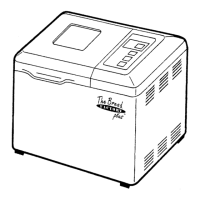I
u
+
Problem Causes
Overrising
. Usually indicates that
ingredient Quantities are out of
proportion. Too much yeast, sugar, flour, IiQuid or a
combination may result in exceeding the capacity of the inner
pot.
Open, Coarse or
. Excess water or yeast was used, or yeast action was
Holey Texture
accelerated by hot, humid weather or overheated ingredients.
. Salt omitted.
Heavy,
● Not enough water or too much flour was used.
Dense Texture
. Not enough sugar or yeast was used.
. Recipe was imbalance by an excess of whole grain flour,
whole grains, dried fruits or other added ingredients.
Short Loaf,
. Not enough sugar was used.
Unsatisfactory
● Delayed finish feature was used and ingredients were placed
Rising
in inner pot in a way that salt or water were in contact with
the yeast for a prolonged period.
● Short, heavier loaves are to be expected when whole grains
or whole grain flours are used or when all-purpose flour is
substituted for bread flour (high grade flour). Try using bread
flour (high grade flour) and reducing the amount of other
flours and grains.
● incorrect amount of yeast was used, or yeast was not fresh.
No rise
● Old or improperly stored yeast was used, Yeast was omitted
or mismeasured.
● Other key ingredients were omitted or mismeasured.
. Delayed Finish feature was used and ingredients were placed
in the pan incorrectly.
Mushroom-Shaped
. Too much yeast may have been used. Be sure yeast was
Top
measured with a teaspoon, not a tablespoon.
●Added ingredients that contain sugar, such as sweetened
applesauce or raisins.
Sunken
● Loaf with top or sides that have caved in could be caused
by too much moisture. Reduce the liquids by 2 tablespoons
the next time you use the recipe.
● If recipes call for fruit or vegetables, drain well and pat them
dry.
–15–

